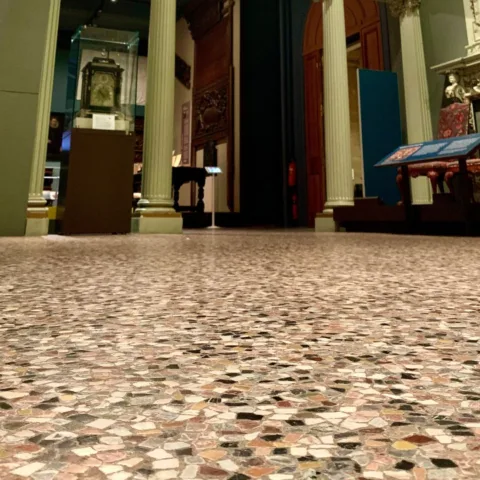The Bowes Museum Blog

Strange Coincidence
Amongst the dazzling display of shoes in The Bowes Museum exhibition this summer was a collection once belonging to the Empress Eugénie, donated to the Museum by the Edlestone family of Gainford (see Hannah Jackson’s Museum blog entry of May 2016). Many of these had been bought from the Viault-Esté establishment, whose label proudly announced their patronage. Their address was Rue de la Paix, one of the most prestigious streets in Paris, running from the Place Vendôme to the Opéra through the 2nd arrondissement.

Viault-Este Label
When I saw the exhibition, I remembered having recently been involved in translating some bills of John and Joséphine, one having an address from the same street. I relocated a receipt dated 1863 (JB/3/3/11/77) from the painter Eugène Feyen for a portrait, costing 1500F (about £40). This was almost certainly the well-known portrait of John Bowes himself (BM 300) “surrounded by more game than he ever shot in his life” according to a report in Charles Hardy’s book. Feyen also painted a pair of pendant pictures showing Joséphine’s sister Anne Antoinette (BM 515) and her grandfather Mowerin Sergent (BM 516). A list in the archive from John’s picture restorer Benjamin Gogué (JB/5/7/8/7) shows that the latter two pictures were framed and gilded in 1862 with the picture of John similarly treated in 1863. In his notes on his picture collection made in 1878, John Bowes writes that the picture of Monsieur Sergent was created posthumously from a chalk drawing taken when he was imprisoned by a revolutionary tribunal in 1792 and that he is shown in the prison uniform called “La Carmagnole”. This may account for an otherwise puzzling letter in the archives from John’s Parisian friend Baron Magliano which goes into considerable (and very gory) detail about the early fifteenth century Venetian general of that name.

Feyen bill

Feyen portraits
Amazingly Monsieur Feyen’s address was not only in the same street, but at exactly the same number, 17. The address is also shown with a portrait of the painter on the card illustrated, sourced from the internet.
Eugène Feyen lived from 1815 to 1908 and trained with Paul Delaroche (as did a number of other painters whose pictures were bought by John and Joséphine). He regularly exhibited at the Paris Salon. Although initially a portrait painter and, as his letterhead shows, an early photographer, he subsequently preferred seascapes and genre paintings, spending summers at Cancale in Brittany. His web entry is sadly quite short but does note that he was admired by Van Gogh who wrote “[Monsieur Feyen is] one of the few painters who pictures intimate modern life as it really is, and does not turn it into fashion plates.”

Eugene Feyen
The firm Viault-Esté appears to have been trading at 17 Rue de la Paix through the 1860s (https://eng.shoe-icons.com/museum/select_brand.htm?brand=354). It would appear therefore that the premises were shared in some way. Probably pure coincidence although maybe a link awaits discovery.
By John Findlay, Library and Archive Volunteer





